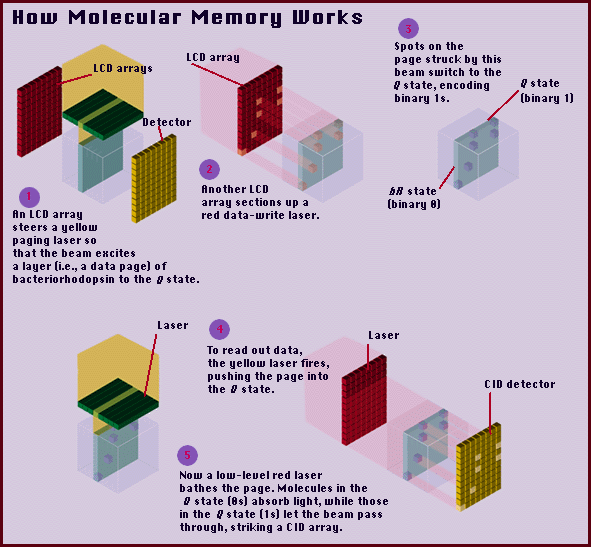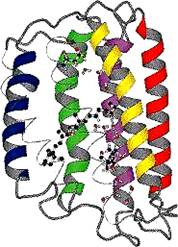





Published on Nov 30, 2023
The bacterio-rhodopsin protein is one of the most promising organic memory materials. Seven helix-shaped polymers form a membrane structure, which contains a molecule known as the retinal chromophor. The chromophor absorbs light of a certain color and is therefore able to switch to another stable state in addition to its original state. Only blue light can change the molecule back to its original state.
There have been many methods and proteins researched for use in computer applications in recent years. However, among the most promising approaches, and the focus of this particular web page, is 3-Dimensional Optical RAM storage using the light sensitive protein bacterio-rhodopsin.
In a prototype memory system, bacterio-rhodopsin stores data in a 3-D matrix. The matrix can be build by placing the protein into a curvette (a transparent vessel) filled with a polyacrylamide gel. The protein, which is in the bR state , gets fixed in by the polymerization of the gel. A battery of Krypton lasers and a charge-injection device (CID) array surround the curvette and are used to write and read data.
While a molecule changes states within microseconds, the combined steps to read or write operation take about 10 milliseconds. However like the holographic storage, this device obtains data pages in parallel, so a 10 Mbps is possible. This speed is similar to to that of slow semiconductor memory.
Bacterio-rhodopsin, after being initially exposed to light (in our case a laser beam), will change to between photo isomers during the main photochemical event when it absorbs energy from a second laser beam. This process is known as sequential one-photon architecture, or two-photon absorption. While early efforts to make use of this property were carried out at cryogenic temperatures (liquid nitrogen temperatures), modern research has made use of the different states of bacterio-rhodopsin to carry out these operations at room-temperature.
Upon initially being struck with light (a laser beam), the bacterio-rhodopsin alters it's structure from the bR native state to a form we will call the O state. After a second pulse of light, the O state then changes to a P form, which quickly reverts to a very stable Q state, which is stable for long periods of time (even up to several years).

The data writing technique proposed by Dr. Birge involves the use of a three-dimensional data storage system. In this case, a cube of bacterio-rhodopsin in a polymer gel is surrounded by two arrays of laser beams placed at 90 degree angles from each other. One array of lasers, all set to green (called "paging" beams), activates the photocycle of the protein in any selected square plane, or page, within the cube. After a few milliseconds, the number of intermediate O stages of bacterio-rhodopsin reaches near maximum. Now the other set, or array, of lasers - this time of red beams - is fired.
The second array is programmed to strike only the region of the activated square where the data bits are to be written, switching molecules there to the P structure. The P intermediate then quickly relaxes to the highly stable Q state. We then assign the initially-excited state, the O state, to a binary value of 0, and the P and Q states are assigned a binary value of 1. This process is now analogous to the binary switching system which is used in existing semiconductor and magnetic memories. However, because the laser array can activate molecules in various places throughout the selected page or plane, multiple data locations (known as "addresses") can be written simultaneously - or in other words, in parallel .

Bacterio-rhodopsin comprises a light absorbing component known as ‘chromophore’ that absorbs light energy and triggers a series of complex internal structural changes to alter the protein’s optical and electrical characteristics. This phenomenon is known as photo cycle.
The initial resting state of the molecule is known as ‘bR’. Green light transforms the initial ‘bR’ state to the intermediate state ‘K’. Next ‘K’ relaxes, forms another intermediate state ‘M’ and then ‘O’ converts to another intermediate state ’P’, which then relaxes to a more stable state ‘Q’. Blue light converts ‘Q’ black to the initial state ‘bR’. Here the idea is to assign any two long-lasting states to the binary values of ‘0’ and ‘1’, to store the required information.
Many of the erstwhile memory devices based on Bacterio-rhodopsin could operate only at extreme cold temperatures of liquid nitrogen, where light-induced switching between ‘bR’ and the intermediate state ‘K’ could be controlled. These devices were much faster than conventional semiconductor-based devices, as these exhibited the speed of a few trillionths of a second. Today, most Bacterio-rhodopsin based devices function even at room temperature, switching between ‘bR’ and another intermediate stable state ‘M’.
If a number of Bacterio-rhodopsin molecules are arranged in a three-dimensional fashion, high-speed, high-density, low-cost memories with vast capacities that can handle large volumes of data can be realized. Such memories offer over 300-fold improvement in storage capacity over their two-dimensional counterparts. Read/Write operations on these can be performed with the help of colored lasers that are fixed at such points as to direct the beams through the required points in the plane of the cube.
Such memory cubes must be extremely uniform in their composition and must be homogeneous to ensure good results, since excess of defect of molecules in one particular region tends to distort the stored information and render the memory cube useless. The entire process of data storage or retrieval can be carried out in few milliseconds. The speed of these memories depends on the number of cubes operating in parallel.
Retrieval of stored data is carried out in a manner similar to storing the information, except that a detector images the light passing through the memory cube and senses 1’s and 0’s. Here the property of selective absorption of red light by the intermediate state ‘O’ is relied upon. The detector senses the luminescent power falling upon it and converts the variations of optical power into a correspondingly varying electric current. An associative memory device that builds on holographic properties of thin films of Bacterio-rhodopsin has been developed.
Associative memories take images of data blocks as input, scan the entire memory independently of a central processor for data block that matches the input, and return the closest match. Such holographic thin films allow multiple images to be stored in the same segment of memory, thereby permitting simultaneous analysis of large sets of data. However, holograms based on Bacterio-rhodopsin are erasable.
| Are you interested in this topic.Then mail to us immediately to get the full report.
email :- contactv2@gmail.com |